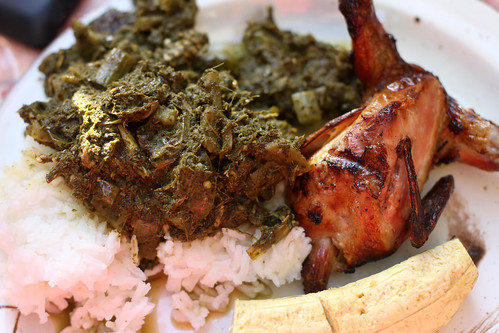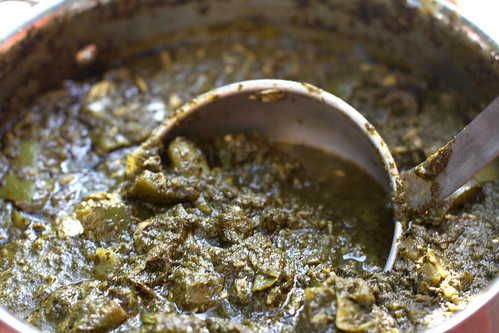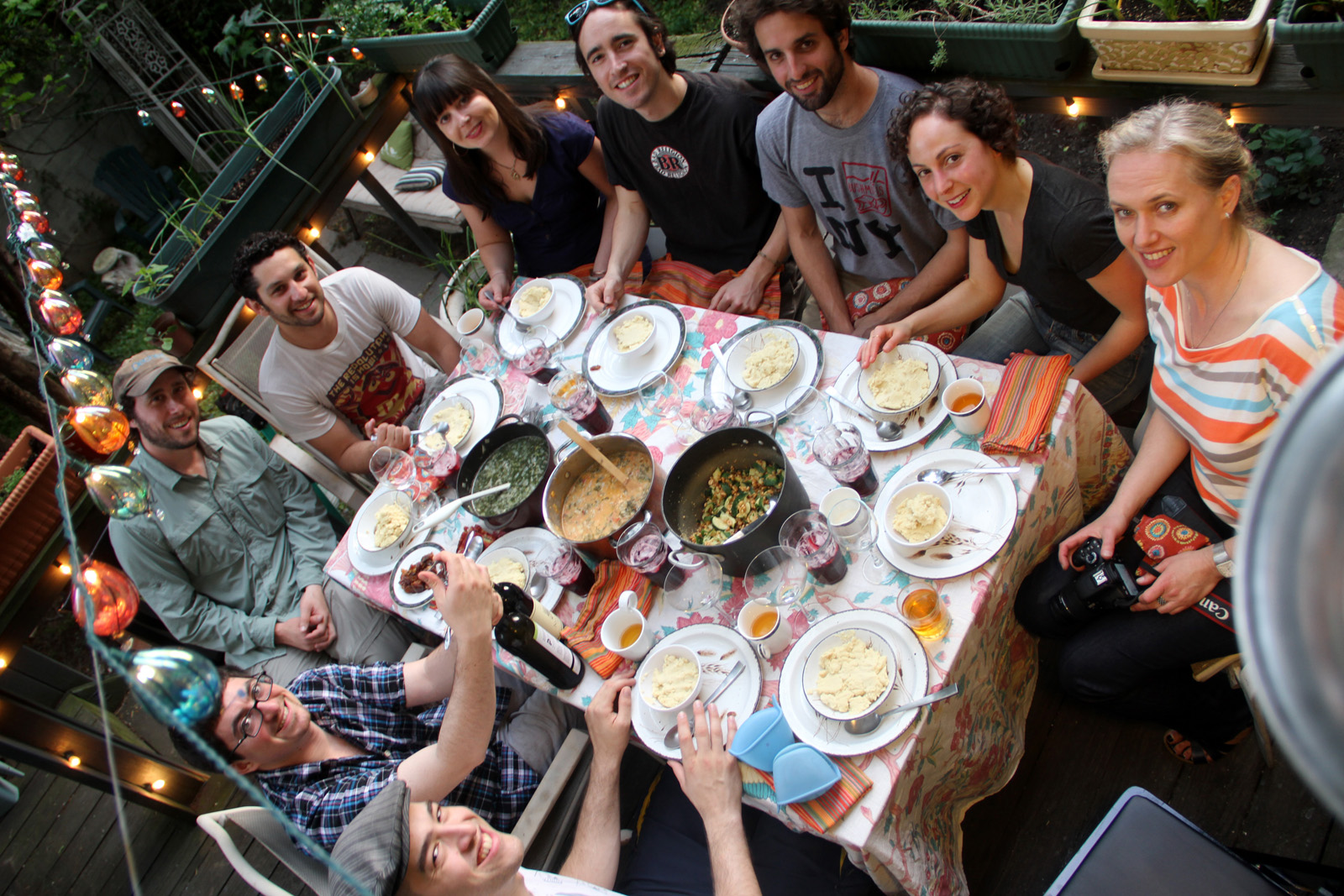 The Gambia, a former British West African colony, is a little sliver of a country, hugging a river of the same name and surrounded by the formerly French Senegal. I find it appropriate that we held this Nosh in Portland, Oregon, a riverine city -- and, thankfully, one that has a few African markets!
The Gambia, a former British West African colony, is a little sliver of a country, hugging a river of the same name and surrounded by the formerly French Senegal. I find it appropriate that we held this Nosh in Portland, Oregon, a riverine city -- and, thankfully, one that has a few African markets!
While Gambia is squarely in West Africa, the food struck me as borrowing major parts from both Central and North Africa. The stew, with peanut butter and palm oil, is similar to many things we've made from the center of the continent, while the rice and couscous dishes remind me quite a bit of North African and even central Asian cooking.

Huge thanks to my aunt Marcia for hosting us, and a bunch of our friends, at her lovely house with a third of an acre for a back yard which doubles as an Urban Farm Collective site. Joining us were Molly, Jens, Eric, Sarah, Alley, Andrew, Viola, Laura, Drew, Suj, Craig, Laura (yes, there were a total of three Lauras there!), Luca, and Marc.
Pepe soup | Spicy chicken and tomato soup | Recipe
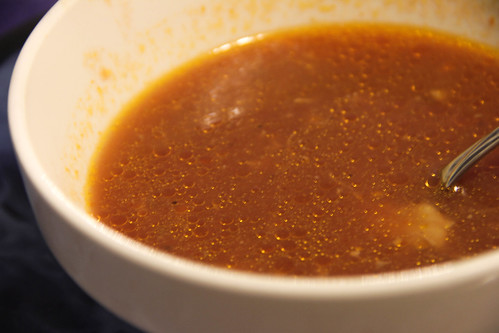
They say a hot, spicy soup on a warm day cools you down. I'm not sure I entirely buy it: I was warm inside, and sweating a bit, but didn't feel much cooler, in the mid-80s heat. Anyway, this is a pretty simple but tasty soup, made of simmering panfried chicken with bouillon and chilies to make a tasty broth, then enriching with tomato paste. The soup was a bit thin, with not a ton of chicken per bowl, but that might be authentic. Also we couldn't find anything resembling the hot African peppers called for; I would have preferred scotch bonnets but the closest we found was serranos. All in all, pretty tasty, I'd use this as a basis for something else in the future. (Maybe throw rice in there to enrich it?)
Benachin | Fish and rice with vegetables | Recipe
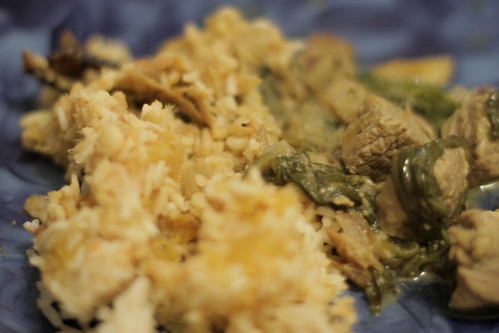
Benachin means "one pot," which is all you should need to cook this dish. The recipe I followed, for a fish version, wasn't the most specific -- it calls for "six white fish" without specifying what type or how big -- so I estimated with about three pounds of ling cod for a double recipe. (The "bongo fish," on the other hand, is clearly a dry-smoked fish with the tail stuffed in its mouth!) We improvised a bit across recipes, throwing in butternut squash and eggplant, and leaving out bitter tomato which we had no chance of coming across. I did my best job of following the technique of steaming the rice above the stew before throwing in, but honestly I don't think it was worth the hassle, next time I'd just throw the rice right in the stew after rinsing. All in all, this was a pretty tasty dish, although I think I made way too much for the crowd!
Plasas | Spinach stew with peanut butter and beef | Recipe
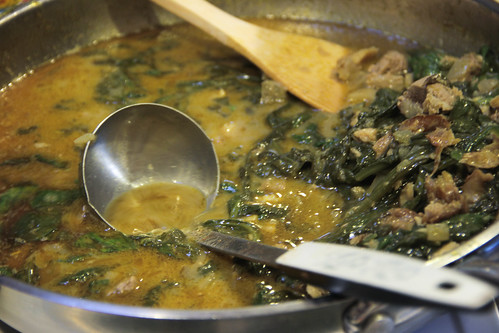
Aunt Marcia had mentioned before I came to town that there was amazing local spinach to be had, so I was happy to find this recipe using spinach. Unfortunately, with their spell of heat the spinach was gone from the farmers markets, but the supermarket still had fine stuff, which we used in place of frozen. Mixed in with that classic technique of simmering beef into a gravy rich with palm oil and a bit of peanut sauce, this was in my mind one of the better of the African stews I've made.
Chakery | Pineapple-dairy sauce over couscous | Recipe

Between the main course and dessert, we went out back and picked marionberries and raspberries from the garden, so naturally they, very incongruously, made their way onto a few plates. I was surprised to see a recipe with so much fresh dairy product from an African country, but then I saw it a few more times and was convinced of its authenticity. There's no added sugar, but between the pineapple (we used fresh instead of canned), evaporated milk, and vanilla yogurt, plus the richness of cooking the couscous in coconut milk and the sour cream in the sauce, this was quite a heady dessert. And yes, the berries went quite well.
We came back to New York the next day, and did a Georgian feast soon after that. The writeup is coming soon!













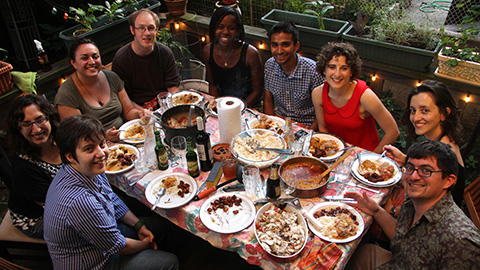

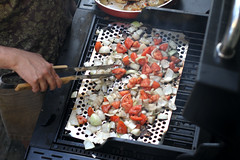






 The larger better-known of the two countries named after the Congo River is the Democratic Republic of Congo, the former Zaire and previously a Belgian colony, but that shows up in the D's. This meal is from the north side of the river, the Republic of Congo, the former French colony, sometimes known as Congo-Brazzaville after its capital.
The larger better-known of the two countries named after the Congo River is the Democratic Republic of Congo, the former Zaire and previously a Belgian colony, but that shows up in the D's. This meal is from the north side of the river, the Republic of Congo, the former French colony, sometimes known as Congo-Brazzaville after its capital.